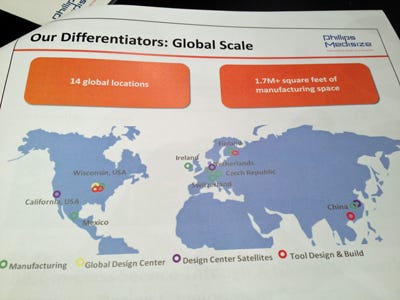Why Medtech Reshoring Is Not Just a U.S. Thing
June 10, 2015
A major contract manufacturing seeks to be a local producer--everywhere around the world.
Chris Newmarker
|
Phillips-Medisize has grown to 14 global locations. |
Medtech outsourcer Phillips-Medisize has greatly expanded its presence in China in recent years, opening a project site in Suzhou a year and a half ago and then announcing the creation of a design and development center there last month.
But this isn't about the classic offshoring of medical device manufacturing away from the United States, Matt Jennings, president & CEO Phillips-Medisize Corp. (Hudson, WI), said during a Tuesday news conference at MD&M East.
"We still see a trend of 'China for China,'" Jennings said.
What Jennings meant by that is that even though there are reasons to bring back production of medtech products for U.S. consumers, it still makes a great deal of sense logistically to manufacture products for Chinese consumers in China.
"I don't see people wavering from their China strategy. It's a big market, and it's going to get bigger. ... There are roughly 350 million people in the middle class in China. That's roughly the size of the United States."
Jennings also noted that there are studies that show there are 120 million people diagnosed with diabetes in China, a huge market for Phillips-Medisize, which among other things designs and manufactures diabetes treatment devices such as insulin pens.
Rising foreign labor costs, supply chain inflexibility, and IP concerns are making it more profitable for many U.S. medtech companies to bring manufacturing back to the United States from China and other countries, Mark Fuhrman, director of sales and marketing at C&J Industries Inc. (Meadville, PA), recently told Qmed.
Jennings, however, sees a more complex situation.
Lower energy costs in the U.S. due to the natural gas boom and improvements in automation mean that it makes sense to make more medical devices for Americans inside the United States, Jennings says. But it also makes sense to make more medical devices for the Chinese inside China.
"That's also driving an opportunity to take labor out, shorten supply chain, and make products where they're going to be consumed. America for America. Europe for Europe. Asia for Asia," Jennings said.
The strategy has helped the privately owned Phillips-Medisize triple its annual revenue to $650 million since 2011.
Chris Newmarker is senior editor of Qmed and MPMN. Follow him on Twitter at @newmarker.
About the Author(s)
You May Also Like


.png?width=300&auto=webp&quality=80&disable=upscale)
